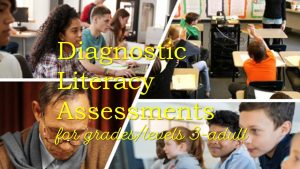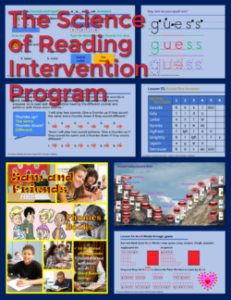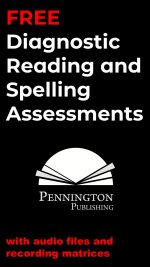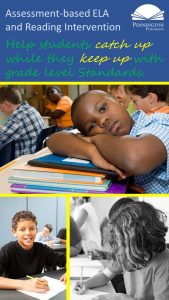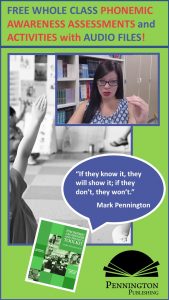FREE Reading and Spelling Assessments for Reading Intervention
Following are accurate and teachable diagnostic reading and spelling assessments and corresponding recording matrices to help teachers determine what students know and what they do not know. All but one assessment (fluency) are whole class assessments. Each assessment is comprehensive, not a random sample, to enable teachers to teach to the results of each test item. The author’s ELA/reading programs provide the resources for assessment-based whole class and individualized instruction. Click on the blue links for the assessment resources and check out the author’s programs, which provide the instructional resources to teach to each assessment.
DIAGNOSTIC READING ASSESSMENTS
Phonemic Awareness Assessments (Printable Copies)
Use these five phonemic awareness (syllable awareness, syllable rhyming, phonemic isolation, phonemic blending, phonemic segmenting) and two awareness assessments (upper and lower case identification and application) to determine reading readiness. Each of the seven assessments is administered whole class. The author’s Teaching Reading Strategies reading intervention program includes corresponding phonemic awareness and alphabetic awareness activities to remediate all deficits indicated by the assessments.
Vowel Sounds Phonics Assessment
(Printable Copy with Links to 10:42 Audio File, Google Forms, and Google Sheets)*
Printable and digital testing options: Use this comprehensive 52 item whole class assessment to determine your students’ mastery of short vowels, long vowels, silent final e, vowel digraphs, vowel diphthongs, and r-controlled vowels. The assessment uses nonsense words to test students’ knowledge of the sound-spellings to isolate the variable of sight word recognition. Unlike other phonics assessments, this assessment is not a random sample of phonics knowledge. The Vowel Sounds Phonics Assessment includes every common sound-spelling. Thus, the results of the assessment permit targeted instruction in any vowel sound phonics deficits. The author’s Teaching Reading Strategies and The Science of Reading Intervention Program reading intervention programs include corresponding worksheets and small group activities to remediate all deficits indicated by this assessment.
Consonant Sounds Phonics Assessment
(Printable Copy with Links to 12:07 Audio File, Google Forms, and Google Sheets)*
Printable and digital testing options: Use this comprehensive 50 item whole class assessment to determine your students’ mastery of consonant digraphs, beginning consonant blends, and ending consonant blends. The assessment uses nonsense words to test students’ knowledge of the sound-spellings to isolate the variable of sight word recognition. Unlike other phonics assessments, this assessment is not a random sample of phonics knowledge. The Consonant Sounds Phonics Assessment includes every common sound-spelling. Thus, the results of the assessment permit targeted instruction in any consonant sound phonics deficits. The author’s Teaching Reading Strategies and The Science of Reading Intervention Program reading intervention programs includs corresponding worksheets and small group activities to remediate all deficits indicated by this assessment.
Heart Words Assessment (Printable Copy)
Use this 108 item whole class assessment to determine your students’ mastery of high frequency English words with non-phonetic parts–“the parts to learn by heart.” The author’s Teaching Reading Strategies and The Science of Reading Intervention Program both include printable Heart Words game cards and fun learning games to help students master unknown Heart Words as indicated by the diagnostic assessment. Perfect differentiated instruction!
Rimes Assessment (Printable Copy)
Use this comprehensive 79 item whole class assessment to determine your students’ mastery of the most common English rimes. Memorization and practice of these word families such as ack, eck, ick, ock, and uck can supplement an explicit and systematic phonics program, such as found in the author’s Teaching Reading Strategies and The Science of Reading Intervention Program reading intervention programs. Experienced reading teachers know that different students respond differently to reading instruction and some remedial students especially benefit from learning onsets (such as consonant blends) and rimes. The program includes small group activities to remediate all deficits indicated by this 15-minute assessment. The program also provides rimes game card masters and individual sets of business card size game cards in the accompanying Reading, Spelling, and Vocabulary Game Cards.
The Pets Fluency Assessment (Printable Copy)
The “Pets” expository fluency passage is leveled in a unique pyramid design: the first paragraph is at the first grade (Fleish-Kincaid) reading level; the second paragraph is at the second grade level; the third paragraph is at the third grade level; the fourth paragraph is at the fourth grade level; the fifth paragraph is at the fifth grade level; the sixth paragraph is at the sixth grade level; and the seventh paragraph is at the seventh grade level. Thus, the reader begins practice at an easier level to build confidence and then moves to more difficult academic language. As the student reads the fluency passage, the teacher will be able to note the reading levels at which the student has a high degree of accuracy and automaticity. Automaticity refers to the ability of the reader to read effortlessly without stumbling or sounding-out words. The 383 word passage permits the teacher to assess two-minute reading fluencies (a much better measurement than a one-minute timing). The author’s Teaching Reading Strategies program includes 48 YouTube recordings of expository articles, each at three different speeds, for modeled readings to practice fluency.
The Diagnostic Spelling Assessment
The 102 item assessment includes the most common previous grade-level spelling patterns.
- Grade 4: K-3 spelling patterns (#s 1-64)
- Grade 5: K-4 spelling patterns (#s 1-79)
- Grade 6: K-5 spelling patterns (#s 1-89)
- Grade 7: K-6 spelling patterns(#s 1-98)
- Grade 8: K-7 spelling patterns (#s 1-102)
The test items are grouped by spelling patterns e.g., the four long /i/ spellings, to make posttest analysis simple. All spelling words are multi-syllabic to prevent students from identifying the words by “sight spellings” and to require recognition of the sound-spelling patterns within the context of syllables.
Assessment Formats
Choose the Diagnostic Spelling Assessment format which best suits your needs:
1. Printable Only: Teacher dictates the number of test items assigned to the grade levels, following the written administrative protocol. Students take the test on binder paper. Teacher corrects assessments according to directions and records spelling deficits on the Spelling Patterns Assessment Mastery Matrix.
Resources: Diagnostic Spelling Assessment teacher administration form; Spelling Patterns Assessment Mastery Matrix.
2. Audio and Printable: Teacher plays the 22:32 “slow speed” Diagnostic Spelling Assessment audio file for grades 4, 5, and 6 students or the 17:26 “fast speed” Diagnostic Spelling Assessment audio file for grades 7 and 8 students. The audio file includes all administrative directions. Students take the test on binder paper. Teacher corrects assessments according to directions and records spelling deficits on the Spelling Patterns Assessment Mastery Matrix.
Resources: Diagnostic Spelling Assessment 22:38 audio file; Diagnostic Spelling Assessment 17:26 audio file; Spelling Patterns Assessment Matrix.
3. Google Forms: Teacher shares either the Diagnostic Spelling Assessment Google Form with the 22:32 “slow speed” for grades 4, 5, and 6 students or the form with the “fast speed” for grades 7 and 8 students. Note that incorrect spellings with be accompanied by the Google red squiggly line indicating a spelling error. Students may be tempted to right click the word and select the correct spelling; however, if the teacher tells the students the purpose of the test and directs them not to self-correct, students will generally follow instructions. Telling students that they will receive the same amount of credit whether the spelling is accurate or not, and using the “fast speed” audio also helps students avoid the temptation of cheating. Teacher uploads the students’ Google Forms into the Spelling Patterns Assessment Mastery Matrix Google Sheets.
Resources: Diagnostic Spelling Assessment Google Forms with the 22:32 “slow speed” audio file for grades 4, 5, and 6 students or the the 17:26 “fast speed” audio file for grades 7 and 8 students; Spelling Patterns Assessment Mastery Matrix Google Sheets.
*****

The Science of Reading Intervention Program
The Science of Reading Intervention Program: Word Recognition includes explicit, scripted instruction and practice with the 5 Daily Google Slide Activities every reading intervention student needs: 1. Phonemic Awareness and Morphology 2. Blending, Segmenting, and Spelling 3. Sounds and Spellings (including handwriting) 4. Heart Words Practice 5. Sam and Friends Phonics Books (decodables). Plus, digital and printable sound wall cards and speech articulation songs. Print versions are available for all activities. First Half of the Year Program (55 minutes-per-day, 18 weeks)
The Science of Reading Intervention Program: Language Comprehension resources are designed for students who have completed the word recognition program or have demonstrated basic mastery of the alphabetic code and can read with some degree of fluency. The program features the 5 Weekly Language Comprehension Activities: 1. Background Knowledge Mentor Texts 2. Academic Language, Greek and Latin Morphology, Figures of Speech, Connotations, Multiple Meaning Words 3. Syntax in Reading 4. Reading Comprehension Strategies 5. Literacy Knowledge (Narrative and Expository). Second Half of the Year Program (30 minutes-per-day, 18 weeks)
The Science of Reading Intervention Program: Assessment-based Instruction provides diagnostically-based “second chance” instructional resources. The program includes 13 comprehensive assessments and matching instructional resources to fill in the yet-to-be-mastered gaps in phonemic awareness, alphabetic awareness, phonics, fluency (with YouTube modeled readings), Heart Words and Phonics Games, spelling patterns, grammar, usage, and mechanics, syllabication and morphology, executive function shills. Second Half of the Year Program (25 minutes-per-day, 18 weeks)
The Science of Reading Intervention Program BUNDLE includes all 3 program components for the comprehensive, state-of-the-art (and science) grades 4-adult full-year program. Scripted, easy-to-teach, no prep, no need for time-consuming (albeit valuable) LETRS training or O-G certification… Learn as you teach and get results NOW for your students. Print to speech with plenty of speech to print instructional components.
Literacy Centers, Reading, Spelling/Vocabulary
decodables for older readers, diagnostic reading assessments, diagnostic spelling assessment, fluency assessment, phonemic awareness assessment, phonics assessment, reading assessments, reading intervention, reading intervention program, spelling assessments, Teaching Reading Strategies
